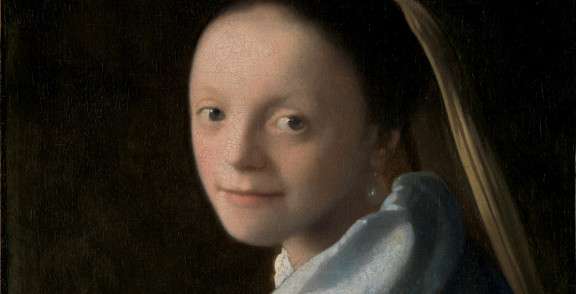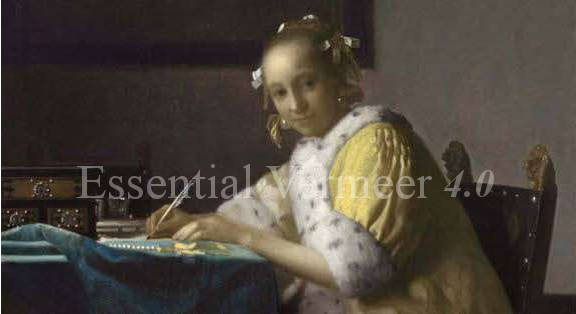Click here to access high quality images of Ter Borch's paintings.





Gerrit ter Borch
Zwolle 1617–Deventer 1681
Gerrit ter Borch (also spelled Terborch, or Terburg (listen to the Dutch pronunciation to the left) developed his own distinctive type of interior genre in which he depicted with grace and fidelity the atmosphere of well-to-do, middle-class life in seventeenth-century Holland.
Ter Borch was one of the most accomplished painters of seventeenth-century Holland, enjoying a considerable reputation in his own day. In the 1640s he adopted a new pictorial type, the full-length portrait, and he contributed to the development of a new genre type, showing simplified interiors with a few figures in an upright format. This composition became an important format for the second half of the 1600s. These compositions are characterized by great refinement in the handling of color, light, and texture and also by a subtle psychological interplay.
- Gerrit ter Borch
- Carel Fabritius
- Pieter de Hooch
- Gabriel Metsu
Ter Borch's father had been an artist and had visited Rome but from 1621 was employed as a tax collector. Surviving drawings made by the young Ter Borch in 1625 and 1626 are proudly inscribed and dated by his father. In 1632 Gerard was in Amsterdam, and in 1634 he was a pupil of Pieter de Molyn in Haarlem. He visited England in 1635, Rome in 1640, and from 1646 spent two or three years in Münster, Westphalia, where the peace congress was in session. The masterpiece of this period, The Swearing of the Oath of Ratification of the Treaty of Münster (1648), portrays the delegates of Holland and of Spain assembled to sign the peace treaty. After a stay in Madrid he finally returned to his own country at the end of 1650, and in 1655 he settled in Deventer.
Ter Borch's works consist almost equally of portraits and genre pieces. His characteristically delicate technique can be appreciated in the portraits, which are painted on a small, almost miniature scale, though many of them are full-length. In color they tend to be subdued, due largely to the sober costume of the times, but by subtlety of tonal gradations and mastery in rendering diverse surface textures he was able to achieve an extraordinary richness of effect. Particularly characteristic is his manner of rendering satin. His superb color sense appears to greater advantage in genre subjects, though it is always employed with masterly restraint. In his earlier years he painted many guardroom subjects in the manner of Pieter Codde and Willem Duyster, but later, from about the time when he finally settled in Holland, he painted calm, exquisitely drawn groups, posed easily and naturally against shadowy backgrounds and imbued with an almost aristocratic elegance that is unique among Dutch painters of his time.
expert opinion: Alejandro Vergara
Gerrit ter Borch (1617–1681) is an important precedent not just for Van Mieris but also for Vermeer and the other artists who specialized in painting domestic interiors from the mid-seventeenth century. The representation of space in his works, his interest in textures and effects of light and shade all represent a clear step forward in the development of the genre. Ter Borch was born in Zwolle and must have trained with his father, Gerrit ter Borch the Elder, known as a poet and topographical draughtsman. In 1634 he moved to Haarlem where he studied with the landscape artist Pieter Molijn and entered the painters' guild. During the next 15 years of his life, he travelled in England, Germany, France and possibly Spain. In 1654 Ter Borch moved to Deventer, where he lived until his death. His focus on interior painting dates from 1645, when he began to paint small-scale works of vertical format which represent elegantly dressed figures. In these paintings, Ter Borch demonstrates his skill in reproducing the textures of the different materials, above all satin, and his ability to focus the viewer's attention on the psychology of his sitters, although in contrast to Vermeer this is a psychology linked to the specific situation which the picture narrates. His paintings of interiors usually feature women in contemplative poses whose beauty and elegance makes them seem like objects that are desirable but also unobtainable, following the model established in the poetry of Petrarch (1304–1374) which was then very much in vogue in Holland.
Ter Borch is a mainly a painter of groups of figures rather than of spaces, and in this he differs from Vermeer and above all De Hooch. He is noted for being primarily responsible for introducing a level of sensuality and refinement into interior painting around 1650 which was not previously evident and which influenced the naturalism of Vermeer, Gabriel Metsu and above all the most faithful disciple of his style, Caspar Netscher (1639–1684), a painter of German origins who worked with Ter Borch in Deventer around the year 1654 and again in 1658–1659.
from:
Alejandro Vergara, Vermeer and the Dutch Interior Madrid: Museo Nacional de Madrid, 2003, 210.















 or anything else that isn't working as it should be, I'd love to hear it! Please write me at:
or anything else that isn't working as it should be, I'd love to hear it! Please write me at: